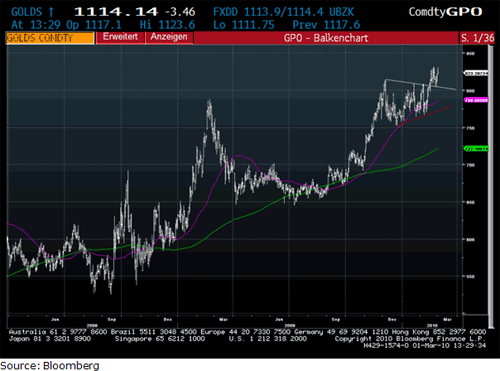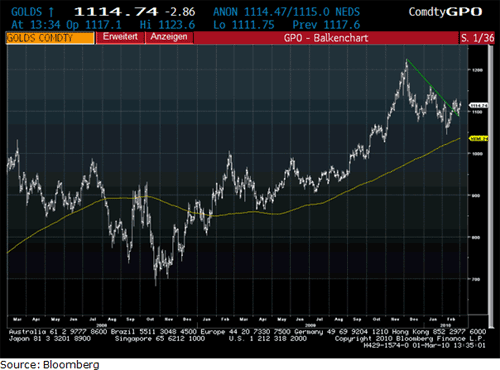IMF Recommends Doubling Inflation Targets!
Economics / Inflation Mar 03, 2010 - 08:46 AM GMTBy: Claus_Vogt
 I grew up in Germany, a country that went through hyperinflation twice during the 20th Century. Maybe that’s the reason I learned inflation is bad and inflationary policies are diabolic.
I grew up in Germany, a country that went through hyperinflation twice during the 20th Century. Maybe that’s the reason I learned inflation is bad and inflationary policies are diabolic.
Inflationary periods are highly unjust. They undermine the ethics of hard work and thrift. They destroy solidarity, lead to widespread hardship and often to social unrest.
All these points are well documented in history. Many countries have suffered through the destruction brought on by huge surges of inflation. And many people have lost their wealth, their savings, and even their perspectives in the wake of inflationary episodes.
Inflation Is the Result of Deliberate Policies
Inflationary periods share three major points:
- They have taken place under fiat money. They are caused by huge public deficits, which are largely financed by money creation.
- They are manmade, always the result of deliberate political decisions.
So where do we stand now?
Well, the first point above has been fulfilled on a global basis since the end of Bretton Woods. And point two is increasingly becoming the political answer to the burst housing bubble.
 |
| On February 12, IMF economists updated their inflation recommendation. |
And now the International Monetary Fund (IMF) comes on the scene: In Rethinking Macroeconomic Policy, IMF economists recommend that the world central banks double their official inflation target from 2 percent to 4 percent.
Hence, point number three has arrived.
Plus, we have …
Ben Bernanke … a Dedicated Inflationist
With Ben Bernanke at the helm of the world’s most important central bank, a designated inflationist is accountable for the world’s most important reserve currency.
In fact, here’s what he had to say during a famous speech on November 21, 2002:
“But the U.S. government has a technology, called a printing press (or, today, its electronic equivalent), that allows it to produce as many U.S. dollars as it wishes at essentially no cost.”
By speaking these characteristic words, the Federal Reserve chairman commended himself for his job as the most important monetary bureaucrat: Promising politicians to always print his way out of any predicament or crisis.
And that’s exactly what he has done during the past years. And that’s exactly what the IMF is now recommending.
So does this mean inflation is no longer a bad thing? No, definitely not.
Inflationary policies are as bad and devastating as they’ve always been! But now they seem presentable. The big problem is, neither Bernanke nor the IMF bureaucrats seem to remember how difficult and painful it is to get the inflation genie back into the bottle once it has been let out.
 |
| When inflation threatens, investors flock to gold to protect their wealth. |
Gold Has Historically Been the Best Inflation Hedge
Economic growth is one of the main, long-term drivers of stock and real estate prices. And when inflation hits there is generally little or even negative growth. Consequently, stocks and real estate do not hold up well.
In contrast, gold has been the best hedge as investors seek to protect themselves against the large purchasing power losses of inflated currencies.
While stocks have been in a secular bear market since 2000, gold has been in a secular bull market. And the inflationary times that loom ahead argue that this bull market has a long way to go. So strategically gold still is a strong buy. But what about the shorter-term picture?
Interestingly, gold in euros has already broken out to an all-time high. As you can see on the chart below, it also broke out of a nice consolidation formation. This is a clear buy signal with a minimum target of 900 euros.

Priced in dollars, gold is also looking attractive. After the strong run from $950 to above $1,200 a healthy correction began. Gold nearly fell back to its rising 200-day moving average. In doing so a wedge formation took shape, and a short-term downtrend line became visible.
As you can see on the following chart, gold broke above this trend line. Then a short-term correction ensued, visible as a test of this broken trend line. This principally bullish behavior is being confirmed by medium-term momentum indicators (not shown). Being oversold, they have turned around thus giving buy signals.

All in all, the situation for gold looks very attractive. Fundamentals are bullish and policy makers are recommending and implementing inflationary policies. The short-term correction that started in December 2009 seems to be over. And I believe gold is ready for a resumption of its long-term bull market.
Best wishes,
Claus
This investment news is brought to you by Money and Markets. Money and Markets is a free daily investment newsletter from Martin D. Weiss and Weiss Research analysts offering the latest investing news and financial insights for the stock market, including tips and advice on investing in gold, energy and oil. Dr. Weiss is a leader in the fields of investing, interest rates, financial safety and economic forecasting. To view archives or subscribe, visit http://www.moneyandmarkets.com.
© 2005-2022 http://www.MarketOracle.co.uk - The Market Oracle is a FREE Daily Financial Markets Analysis & Forecasting online publication.



